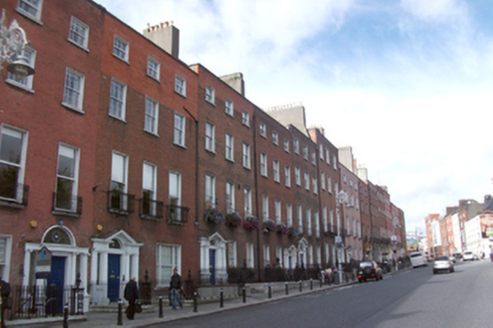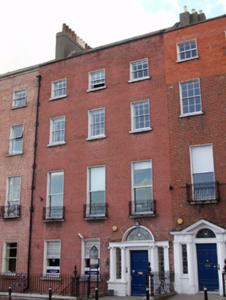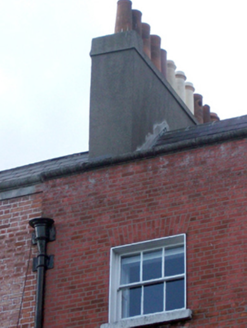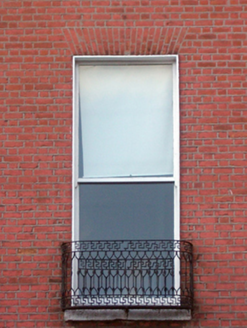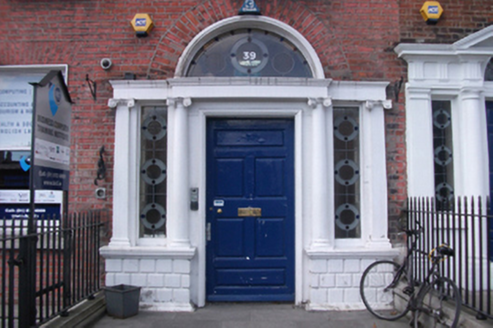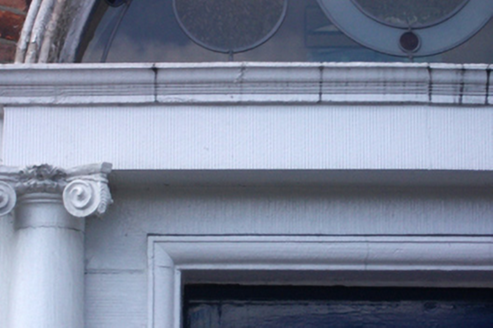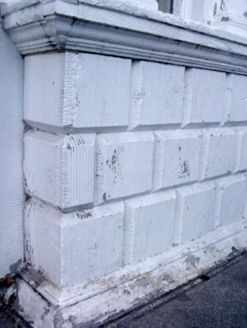Survey Data
Reg No
50010640
Rating
Regional
Categories of Special Interest
Architectural, Artistic
Original Use
House
In Use As
Building misc
Date
1760 - 1770
Coordinates
315588, 235010
Date Recorded
29/09/2011
Date Updated
--/--/--
Description
Terraced three-bay four-storey house over exposed basement, built c.1765. Now in use as offices and educational centre. Pitched artificial slate roof behind red brick parapet wall with moulded granite coping. Rendered chimneystacks with clay pots to party walls, full-depth chimneystack shared with No. 40 to north. Cast-iron rainwater goods throughout. Flemish bond red brick walls with granite ashlar plinth course and granite ashlar plat band over painted rendered, ruled-and-lined walls to basement level. Scrolled wrought-iron brackets flanking doorcase. Gauged red brick flat-arched window openings with rendered reveals and granite sills. Recent replacement six-over-six pane timber sliding sash windows to basement openings, historic replacement one-over-one pane windows to ground and first floors, six-over-six pane to second floor and three-over-three to top floor. Cast-iron balconettes to first-storey openings. Square-headed door opening within tripartite painted stone Ionic doorcase having engaged columns with responding pilasters to sidelights, on rusticated plinths, with entablature and cornice surmounted by replacement stained-glass fanlight within moulded archivolt, latter having gauged red brick voussoirs above. Replacement timber door and replacement stained-glass sidelights. Door opens onto granite flagged platform bridging basement area, enclosed by replacement wrought-iron railings with boxed corner posts on original and replacement granite plinth. Matching gate accessing limestone flagged basement via recent galvanized steel staircase with cast-iron handrail.
Appraisal
Located within an extensive historic terrace, this fine townhouse forms an integral component of the streetscape. The form, proportions and diminishing windows are all characteristic of Georgian townhouses, and the use of timber sash windows enhances this impression. The rusticated plinth detailing to the well-executed doorcase is an unusual detail, usually seen in the work of Richard Castle. The froeground details, while much replaced by reproductions, sets off the building. The house was once the home of the 1st Earl of Enniskillen, and later the Warren family of Killiney Castle, Co. Dublin. Parnell Square itself was the creation of Dr Bartholomew Mosse. In 1748 he leased four acres at the junction of three important sites: the Gardiner Estate, Sackville (now O’Connell) Street and Great Britain (now Parnell) Street. There the New Gardens (now the Garden of Remembrance) were constructed, a landscaped tract of land with illuminated paths, obelisks and a loggia. Entrance fees to the gardens funded the construction of the Rotunda Hospital to the south, Mosse’s life ambition, and the success of the gardens precipitated the development of the surrounding square, largely by the hospital's chief builders.
